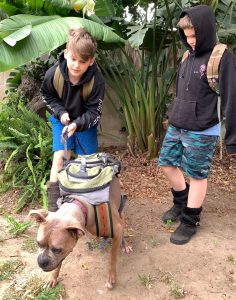Learn to separate microchipping facts from fiction!
Diane Stevenett, Co-Author of the International Award Winning Book
This article was syndicated by #ExpertClick : https://www.expertclick.com/NRWire/Releasedetails.aspx?id=238908
Having a microchip implanted will hurt my pet.
FICTION:
No anesthetic is required for a microchip implant. The procedure is performed at your veterinarian’s office and is simple and similar to administering a vaccine or a routine shot.
The microchip comes preloaded in a sterile applicator and is injected under the loose skin between the shoulder blades. The process takes only a few seconds, and your pet will not react any more than he would to a vaccination.
FACT:
Pet microchips work like global positioning devices (GPS) and tell me my pet’s location.
FICTION:
Pet microchips are not tracking devices. They are radio-frequency identification (RFID) implants that provide permanent ID for your pet.
Because they use RFID technology, microchips do not require a power source like a GPS. When a microchip scanner is passed over the pet, the microchip gets enough power from the scanner to transmit the microchip’s ID number. Since there’s no battery and no moving parts, there’s nothing to keep charged, wear out, or replace. The microchip will last your pet’s lifetime.
FACT:
My pet wears a collar with tags, so he doesn’t need a microchip.
FICTION:
All pets should wear collar tags imprinted with their name and the phone number of their owner, but only a microchip provides permanent ID that cannot fall off, be removed, or become impossible to read.
FACT:
Microchips are expensive.
FICTION:
The average cost to have a microchip implanted by a veterinarian is around $45, which is a one–time fee and often includes registration in a pet recovery database.
If your pet was adopted from a shelter or purchased from a breeder, your pet may already have a microchip. Consult your pet adoption paperwork, or have your pet scanned for a microchip at your next vet visit to reveal the unique microchip ID number and register it.
FACT:
Only dogs, not cats, need to be microchipped.
FICTION:
Both cats and dogs need to be microchipped.
Cats often do not wear collars, and may not have any other form of ID. A recent study showed that less than 2% of cats without microchips were returned home. However, if a cat is microchipped, the return-to-owner rate is 20 times higher than if the cat was not microchipped.
FACT:
My contact information is contained in the chip, and anyone with a scanner can access it.
FICTION:
Microchips carry only a unique identification number.
If your pet gets lost and is taken to a vet clinic or animal shelter, your pet will be scanned for a microchip to reveal his unique ID number. That number will be called into the pet recovery service, and you will be contacted using the contact information on file with your pet’s microchip.
**It is vital to keep your contact information up to date so that you can be reached.
FACT:
FICTION:
I need to microchip my pet more than once.
A microchip will normally last the lifetime of your pet because it is composed of biocompatible materials that will not degenerate over time.
The HomeAgain® microchip has the Bio-Bond™ patented anti–migration feature to help ensure the chip stays where it’s implanted. Also, since microchips require no power source and have no moving parts, there’s nothing that can wear out and need to be replaced. Pet owners can also check to make sure their pet’s microchip is still working by asking a vet to scan it during their pet’s next checkup.
FACT:
Having a microchip gives a pet the best protection if he gets lost.
FICTION:
A microchip is only the first step! You must register your pet’s microchip to give your pet the best protection.
Register your pet’s microchip in a national pet recovery database such as HomeAgain with your contact information, so you can be contacted when your lost pet is found. Also, remember to keep your contact information up to date whenever you move or change phone numbers.
RUN RUN RUNAWAY
Harley is a rescue dog and only one-year-old. When I got him they told me he was a runner, but I did not heed their warning. The first time Harley escaped, he ran to a nice lady’s house and went right in. She took him to a local vet who scanned him and called me and I was very happy to have him back. Well, two months later, while I was cutting the grass, I accidentally left the gate open and Harley took off again. I felt so silly for leaving the gate open and immediately ran after Harley, searching the entire neighborhood for him. I drove all around the second day and continually walked to the street to see if he could have been hit by a car. On the third day I went to the animal shelter to see if they picked him up, but he was not there. When I got home, I received a call from the Atlantis Fl. Police Department. A very nice officer’s mother had found Harley and called her son who was able to scan Harley’s microchip and trace him back to me as the pet parent. If not for Harley’s HomeAgain chip, I would not have my furbaby back today. Needless to say, I was a very happy man and thankful for the officer and for Harley’s chip and HomeAgain. Thank you HomeAgain! USED BY PERMISSION: Posted By: Ed, Boynton, FL – 2/28/2014 Pet Name: Harley Species: Dog Breed: Miniature Pinscher Sex: Male
Much more complete information in Chapter 2 of
How To Save Your Pet From A Disaster
Be “pet prepared.” Remember, your pet may turn into your “therapy animal” in a disaster! They are part of your family, mostly helpless, so this guide book gives you ideas to help you plan ahead and protect them. Easy to read and understand, this complete treasure trove of gold quality tips will help you discover essential information you’ve never thought of to better help your pet not get lost, not freak out, stay safe and be a close companion during stressful moments. You may have ideas, plans or supplies ready for you and your family to deal with an emergency, but your furry and feathered children have different needs, specialized needs. Here is a new book just out, as Chicken Soup for the Soul Author Raymond Aaron says, “A must read! Gift one today!”” How To Save Your Pet From A Disaster, THE essential emergency preparedness guide for feathered friends and fur babies. It even won and international book award for the “Best Pet Care Guidebook.” (available also on Kindle).
While at a glance, it looks like a pet care book, actually, If your house was on fire and you had to grab and go, would you grab your house pet or your family heirloom? Both are heartfelt treasures that you would regret losing… for years. But heirlooms and house pets don’t mix!!! At any given time we can have items in the lab damaged by pets… its quite common. This book is full of tips for protecting your pet and collectible care and maintenance. Order from Amazon now at https://www.amazon.com/dp/B08MS5KJLT



Recent Comments